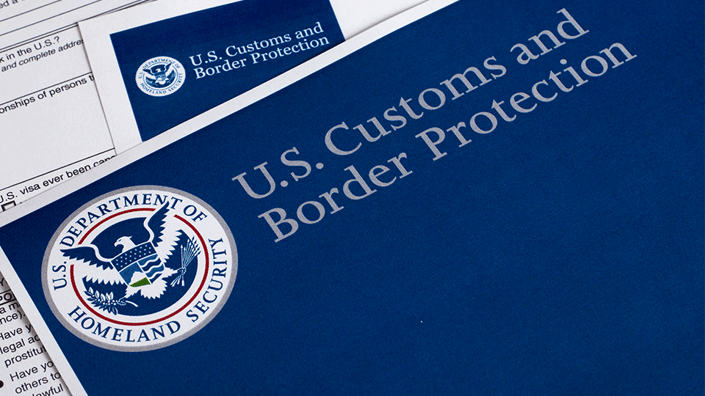Importing freight into the U.S. from another country can feel intimidating — especially if you don’t have a lot of experience doing so. Getting cargo through customs efficiently is important; a delay at the border can set your timelines back substantially, making it more difficult to develop trusting relationships with your customers.
If you’ve ever struggled to clear freight through U.S. customs in the past, it’s likely because documents weren’t filed correctly or your customs broker didn’t properly advise you throughout.
Honestly, importing freight to the U.S. is a relatively uniform process. And once you get comfortable with it, doing so shouldn’t be much of an issue. That said, several segments of this process are important to understand.
Anderson Trucking Service (ATS) helps companies import their cargo to the U.S. frequently. Whether it’s a large project encompassing many breakbulk pieces of cargo or multiple loads of containerized freight, our experience in this realm encompasses many modes of transport.
This article is an overview of the U.S. customs clearance must-knows, including what documents are needed, when they should be filed and what steps should be taken to ensure success.
What Is The Process of Importing to The U.S.?
Your exact process for getting cargo to the U.S. will vary depending on the type of freight you’re moving and its selected method of transport. Some goods are sent overseas via airplane and marine vessel while others enter overland by train or truck.
Although your overall transportation concept — as arranged by your provider(s)/freight forwarder — will be unique, successfully clearing U.S. customs is a consistent six-part process.
Step 1) The Cargo’s Carrier Approves Shipment With Bill of Lading
Once the soon-to-be-imported freight reaches its place of export — be it a marine port, an airstrip or is picked by a cross-border carrier — its operator will receive its bill of lading and sign-off on its arrival.
This serves as a receipt, documenting the freight’s initial admittance to the vessel/airplane/truck/train it will be transported by. A properly notated bill of lading must be presented to U.S. Customs and Border Protection (CBP) to successfully gain import.
Step 2) An Electronic Cargo Declaration is Sent to CBP
An electronic cargo declaration must be filed using one of CBP’s approved electronic data interchange systems 24 hours before freight is loaded onto its departing mode of transport.
These electronic declarations should outline pertinent cargo details such as:
- When the vessel is scheduled to depart
- The last foreign port that vessel will be departing
- The carrier’s Standard Carrier Alfa Code (SCAC)
- The date that the vessel is scheduled to arrive at a U.S. customs location
- Descriptions of the freight, container number(s), serial numbers of container seals
- The address of the owner of the goods/consignee of the cargo.
With this information, CBP officials will make determinations as to whether cargo needs to undergo further examination upon arrival in the U.S.
Step 3) Importer Receives Notice of Arrival When Cargo Arrives at Entry Point
Prior to the cargo arriving at its entry point, the “notify party” stated on the bill of lading will receive an arrival notice from the ocean carrier. This document is given to the customs broker to begin their portion of the customs clearance.

Step 4) Customs Documents are Submitted to CBP
At this point, all entry documents can be submitted to CBP. This can either be done by the importer themselves or by their assigned customs broker using an approved electronic interchange system or at the port/location where the goods arrived.
All entry documentation must be electronically submitted to CBP using their Automated Commercial Environment (ACE) portal within 15 days of the cargo’s arrival in the U.S.
Here are the entry documents that must be submitted to CBP within this timeframe:
Bill of lading(s)
The cargo’s completed bill of lading will be submitted to CBP with other entry documents. Although the type of bill of lading (BOL) your freight has will vary based on its mode of transport (there are multiple kinds of BOLs), it must be included here.
CBP Form 3461
Form 3461 is CBP’s official entry form, listing important information about all parties involved in the commodity’s transport, where it originated and where it’s destined for, who the owner of the cargo is and other transit-specific details.
This form is fundamental to the U.S. customs clearance process as it helps CBP determine whether entrance should be allowed or if further examination is necessary.
CBP Form 7501 - Entry summary
Form 7501 is another entry form you and your customs broker will need to file. This document serves as an entry summary — providing context for CBP to use for classifications and appraisements.
Among other things, Form 7501 should include the description and Harmonized Tariff Schedule (HTS) number of each piece of cargo. If you don’t know your commodity's specific HTS, the exporter should. If not, you can search the HTS database for your number here.
Form 7501 must be filed within 10 working days of when cargo is released by customs.
Commercial Invoice
A commercial invoice, which is essentially the receipt of sale for a given shipment, is an entry document that must always be filed. Every commercial invoice should include the following information:
- The declared value of all merchandise being moved
- Each commodity’s full description and HTSUS number
- The name, address and distinguishing information for the party selling the goods
- The name, address and distinguishing information for the party purchasing the goods
Packing List
The packing list outlines specific information about the imported cargo including its final destination and the dimensions/quantities of each item. Packing lists help U.S. customs officials understand the freight and determine the next steps for its import.
Customs Bond
The final document you’ll want on file with CBP is your import customs bond.
Without a customs bond in place, no shipment can enter the U.S. as these documents protect CBP and U.S. in the event that duties and taxes aren’t paid.
In a nutshell, customs bonds serve as a contract between the principal importer or shipper of a product, a Surety company and CBP. An issued line of credit from a Surety company to the U.S. government ensures that the principal party responsible for paying for a shipment's taxes, duties and fees does so.
There are two types of customs bonds importers can opt for; single entry bonds and continuous entry bonds.
As the name suggests, single entry customs bonds are good for a one-off cargo entry into the U.S.
Alternatively, continuous entry bonds remain valid for an ongoing period of time. Typically, continuous bonds are used when businesses repeatedly and consistently need to clear items through U.S. customs.
Depending on your cargo’s requirements and the frequency with which you import freight, the customs bond you submit will change.

Step 5) CBP Makes Determinations for the Release of the Cargo
Once all entry documents are submitted, this action serves as a formalized request for customs release and U.S. entry. At this point, goods are either cleared for entry or are flagged for further analysis.
Should your cargo be cleared for entry, duties and taxes, as well as any ancillary fees, must be paid at this point. The duties and fees associated with your import will change depending on your cargo’s Harmonized System (HS) code — a 6-digit number commonly used to classify items participating in international trade and standardized for universal recognition.
Find your HS code here (HS codes are the first six numbers of the 10-digit HTS number).
If your cargo is held for further inspections, CBP officials will take steps to determine whether it can be admitted for entry. In some instances, cargo may be seized or held until the steps specified for release are completed. Work with your CBP-approved customs broker to navigate this process and amend any issues that arise.
Step 6) Cargo is Cleared for Entry Into the U.S.
Once all examinations have been completed, all taxes, duties and fees have been paid and CBP Form 7501 is electronically filed, cargo may be collected by the importer for the remainder of its journey.

Related: 5 Things to Understand When Making Pickup Arrangements For Your Port Freight
How Long Does U.S. Customs Clearance Take?
If these steps leave you feeling wary of the customs clearance process, don’t worry. From the moment your cargo arrives at its entry point, clearing customs should take no more than 24-72 hours — provided everything is handled properly on the front end.
Sometimes, customs officials may elect to conduct an entry summary review (when documentation is missing or duties were calculated incorrectly). Either way, it’s recommended that you hold onto all customs clearance documents for five years at a minimum.
Shipping freight across U.S. land borders? Check out these articles for more specific information:
- Freight Shipping Cross Border To and From Mexico: Your Ultimate Guide
- How to Ship Freight Across the U.S.-Canada Border Successfully
- Mexico Customs Clearance: How Long Does it Take and How Should You Plan?
Here at ATS, we take pride in helping companies like yours navigate even the most intricate processes — as international shipping can be. To do so, we release content to our Learning Hub multiple times per week. If you’re interested in being notified each time new educational content goes live, subscribe today.
Now that you have a better understanding of the U.S. customs clearance process, and what’s required of you as an importer, you likely still have any questions about your next international shipment.
If you need clarification on any of the points posted above, or are wondering how ATS can help you move your next load, don’t hesitate to reach out. We have an international shipping expert standing by and ready to answer any questions you may have.




